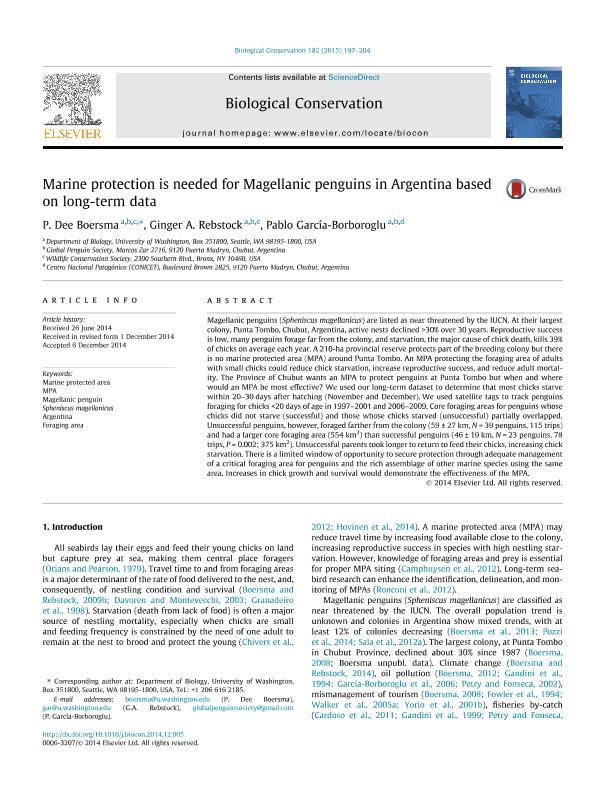Mostrar el registro sencillo del ítem
dc.contributor.author
Boersma, P. Dee
dc.contributor.author
Rebstock, Ginger A.
dc.contributor.author
Garcia Borboroglu, Jorge Pablo

dc.date.available
2017-06-23T21:27:49Z
dc.date.issued
2015-02
dc.identifier.citation
Boersma, P. Dee; Rebstock, Ginger A.; Garcia Borboroglu, Jorge Pablo; Marine protection is needed for Magellanic penguins in Argentina based on long-term data; Elsevier; Biological Conservation; 182; 2-2015; 197-204
dc.identifier.issn
0006-3207
dc.identifier.uri
http://hdl.handle.net/11336/18838
dc.description.abstract
Magellanic penguins (Spheniscus magellanicus) are listed as near threatened by the IUCN. At their largest colony, Punta Tombo, Chubut, Argentina, active nests declined >30% over 30 years. Reproductive success is low, many penguins forage far from the colony, and starvation, the major cause of chick death, kills 39% of chicks on average each year. A 210-ha provincial reserve protects part of the breeding colony but there is no marine protected area (MPA) around Punta Tombo. An MPA protecting the foraging area of adults with small chicks could reduce chick starvation, increase reproductive success, and reduce adult mortality. The Province of Chubut wants an MPA to protect penguins at Punta Tombo but when and where would an MPA be most effective? We used our long-term dataset to determine that most chicks starve within 20–30 days after hatching (November and December). We used satellite tags to track penguins foraging for chicks <20 days of age in 1997–2001 and 2006–2009. Core foraging areas for penguins whose chicks did not starve (successful) and those whose chicks starved (unsuccessful) partially overlapped. Unsuccessful penguins, however, foraged farther from the colony (59 ± 27 km, N = 39 penguins, 115 trips) and had a larger core foraging area (554 km2) than successful penguins (46 ± 19 km, N = 23 penguins, 78 trips, P = 0.002; 375 km2). Unsuccessful parents took longer to return to feed their chicks, increasing chick starvation. There is a limited window of opportunity to secure protection through adequate management of a critical foraging area for penguins and the rich assemblage of other marine species using the same area. Increases in chick growth and survival would demonstrate the effectiveness of the MPA.
dc.format
application/pdf
dc.language.iso
eng
dc.publisher
Elsevier

dc.rights
info:eu-repo/semantics/openAccess
dc.rights.uri
https://creativecommons.org/licenses/by-nc-sa/2.5/ar/
dc.subject
Marine Protected Areas
dc.subject
Magellanic Penguins
dc.subject
Sw Atlantic Ocean
dc.subject
Long/Term Data
dc.subject
Mpa
dc.subject
Spheniscus Magellanicus
dc.subject
Argentina
dc.subject
Foraging Area
dc.subject.classification
Conservación de la Biodiversidad

dc.subject.classification
Ciencias Biológicas

dc.subject.classification
CIENCIAS NATURALES Y EXACTAS

dc.title
Marine protection is needed for Magellanic penguins in Argentina based on long-term data
dc.type
info:eu-repo/semantics/article
dc.type
info:ar-repo/semantics/artículo
dc.type
info:eu-repo/semantics/publishedVersion
dc.date.updated
2016-11-23T19:39:49Z
dc.journal.volume
182
dc.journal.pagination
197-204
dc.journal.pais
Países Bajos

dc.journal.ciudad
Amsterdam
dc.description.fil
Fil: Boersma, P. Dee. University of Washington; Estados Unidos. Global Penguin Society; Argentina. Wildlife Conservation Society; Estados Unidos
dc.description.fil
Fil: Rebstock, Ginger A.. University of Washington; Estados Unidos. Global Penguin Society; Argentina. Wildlife Conservation Society; Estados Unidos
dc.description.fil
Fil: Garcia Borboroglu, Jorge Pablo. University of Washington; Estados Unidos. Global Penguin Society; Argentina. Consejo Nacional de Investigaciones Científicas y Técnicas. Centro Científico Tecnológico Conicet - Centro Nacional Patagónico; Argentina
dc.journal.title
Biological Conservation

dc.relation.alternativeid
info:eu-repo/semantics/altIdentifier/url/http://www.sciencedirect.com/science/article/pii/S0006320714004789?via%3Dihub
dc.relation.alternativeid
info:eu-repo/semantics/altIdentifier/doi/http://dx.doi.org/10.1016/j.biocon.2014.12.005
Archivos asociados
